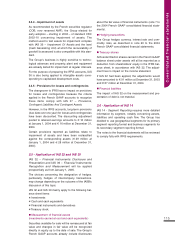APC 2004 Annual Report Download - page 114
Download and view the complete annual report
Please find page 114 of the 2004 APC annual report below. You can navigate through the pages in the report by either clicking on the pages listed below, or by using the keyword search tool below to find specific information within the annual report.
112
2 - Impact on the consolidated
financial statements
2.1 - Adjustments arising
from the first-time adoption of IFRS
The opening IFRS balance sheet at January 1, 2004
has been prepared using the following options allowed
under IFRS 1-
First-Time Adoption Of IFRS:
Business combinations carried out prior to January
1. 2004 have not been restated.
Cumulative unrecognized actuarial gains and loss-
es for defined benefit plans (off balance sheet) have
been recognized as liabilities through equity.
Cumulative translation adjustments have been reset
to zero against retained earnings with no impact on
total equity at January 1, 2004.
IAS 39 will be applied prospectively from January 1,
2005.
The other options available under IFRS 1 have not
been used, particularly that of remeasuring property,
plant and equipment and intangible assets at fair
value.
2.2 - Financial statements presentation
Income statement presentation
The presentation of the income statement has been
changed to comply with IAS 1. The main change con-
cerns items classified as exceptional in the French
GAAP accounts which are reported above the line in
the IFRS income statement in operating revenue or
expense.
In addition research and development costs have
been reclassified, as explained in note 2.3.1 below.
Earnings per share
Earnings per share in the French GAAP accounts are
already calculated in accordance with IAS 33 -
Earnings Per Share.
Diluted earnings per share are calculated by adjusting
net income and the number of shares outstanding for
the dilutive effect of exercise of outstanding stock
options. The dilutive effect of stock options is deter-
mined by applying the "treasury stock" method (theo-
retical number of shares purchased at average mar-
ket price with assumed proceeds from exercise of
rights).
Balance sheet presentation
In accordance with IAS 1 -
Presentation of Financial
Statements,
the balance sheet separates current and
non-current assets and liabilities. To facilitate compar-
ison, the same presentation has been used for the
French GAAP figures.
Cash flow statement presentation
Preparation and presentation of the French GAAP
statement of cash flows complies with the require-
ments of IAS 7 -
Cash Flow Statements.
Restatements under IFRS have no impact on cash
flow.
2.3 - Changes in accounting principles
and policies
2.3.1 - Intangible assets
Intangible assets generated by research and
development activities
The Schneider Electric Group currently invests the
equivalent of around 5 % of sales in research and
development.
Of this amount, development costs for new products
and comprehensive product upgrades may be capi-
talized under IAS 38 -
Intangible Assets.
In 2004, systems were set up to track and capitalize
these costs. As a consequence, only development
costs for new products launched since 2004 are cap-
italized in the IFRS accounts.
D
evelopment costs capitalized in 2004 amount to
46 million. These costs are being amortized over
the estimated life of the underlying technology, which
averages 5 years.
A substantial proportion of development costs con-
sists of maintenance or quality value engineering
costs for existing products, which do not qualify for
capitalization under IAS 38. In the IFRS accounts,
these costs continue to be charged directly to the
income statement; however, they are reclassified
under "Cost of sales" and included in the carrying
value of inventories where appropriate. Only research
expenses remain presented as "Research and
Development expenses" as they are not capitalizable.
The resulting effects in the Statement Income are as
follows:
Capitalization of qualifying development costs for
46 million.
Reclassification as "cost of sales" for 195 million
of maintenance and quality value engineering costs
included in the value of inventories (see 2.3-3 below).
The amount reported under "Research and develop-
ment expenses" corresponds solely to research costs.
Intangible assets previously recognized
in the balance sheet
All intangible assets carried in the opening French
GAAP balance sheet at January 1, 2004 comply with
the definition contained in IAS 38.
Deferred charges recognized in the French GAAP bal-
ance sheet have been reclassified under intangible
assets (1 million at January 1, 2004 and 2 million
























